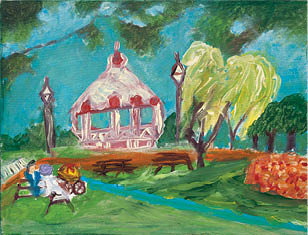A return to creative freshness
Paulo Klein
AICA Association Internationale des Critiques D’Art
ABCA Associação Brasileira de Críticos de Arte
“...the moon reigns over the artists who remain aloof from academia”
Carlos Drummond de Andrade
in “Teimosia da Imaginação” by Germana Monte-Mor
“I should have learned to drive a car, but I chose to paint pictures.”
Aurelino dos Santos, popular painter, Salvador-BA
The history that has led up to this Bienal Naïfs do Brasil, in its 11th edition, began in the 1980s with annual exhibitions that continued until 1992 (the 6th edition) and were entitled, with small variations, Arte Ingênua e Primitiva — Mostra Internacional [Ingenuous and Primitive Art — International Show], always based at SESC Piracicaba, but sometimes expanding out into the pleasant city in the interior of São Paulo state. The exhibition then began to be held every two years, receiving the title Bienal Naïfs, the name under which it is currently recognized in Brazil and internationally.
The exhibition was initially coordinated for various years by Antonio do Nascimento, who gradually enlarged his passion for this segment, linking artists and art critics and inviting them to these occasions where they had the opportunity to maintain contact with this specific and disarticulated production generally made at the fringe of the art world and in rural settings or small towns, that mixed mellifluous naive artists, domesticated brute artists and primitivist artists of various generations. Initially involving a competitive show, at a certain moment it began presenting special rooms by invited artists.
This format lasted until 2004, when during my curatorship of the event’s 7th edition I proposed that the competitive segment be kept — since it allowed for the visibility and circulation of the producers of this art — but accompanied by a reflexive show that would foster the discussion and interaction of this sort of art with other segments of the arts, regardless of whether it was called popular, cabocla, fringe, nonacademic, ingenuous, innate, or contemporary art, among other possibilities.
Returning to the Bienal Naïfs eight years later as a member of the selection and awards jury has allowed me to carry out some reflections. First of all, about the act of judging a work of art within the current context of nearly instantaneous virtual communication and the pendulumlike oscillation of tastes; if it is pertinent or not, good or bad, appreciable or not. The wealth and diversity of impressions, arguments and convictions should be documented on video to later become the subject of philopoetic discourses. In any case, this critical exercise allows for unfathomable challenges, the core of my occupation.
On the present jury I had to cope with some premises, such as the size of the exhibition space, shared in this edition with contemporary artists indicated by curator Kiki Mazzucchelli and with options of acquisition aimed at making the institution’s collection more organic.
The members of the jury thus carried out their work rigorously, not only in regard to what they consider pertinent or not in this complex specificity, but also sought to eliminate the presence of mellifluous naive artists, the ingenuous artists inebriated in a false atmosphere or the replicas of other creators. This was a challenging task that gave rise to exciting clashings that fuel the contemporary production while also questioning it.
The result is a concentrated essence of what is being produced today in Brazil in this segment that blends the painting of relative ingenuousness (even the world of crack cocaine, the large garbage dumps and trash recycling have appeared as themes), the art of outsiders who are fascinating for their originality (including their biographies full of humor, suffering or tragedy), as well as masters who have evolved their technique over long years, without losing their (often rustic) poetics or their own identity.
The artworks and artists awarded the Acquisition Prize include two creations by Adão Domiciano Pinto, an artist from Cuiabá, Mato Grosso, already known from other biennials for his incisive painting, who returned to this edition with the novelty of using watercolor on paper applied on a board. This new medium is consistent in a satisfactory and appealing way with the controversial theme of 21st century slavery, still found in some regions of the country.
Fishing is the theme of Jefer (Jefferson Bastos), from Campo Grande, Mato Grosso do Sul, another Acquisition Prize winner, in a painting of simple primitivism in which the landscape and the characters are schematic and the tones maintain the lightness of children’s drawings.
Among the Incentive Prizes, we call special attention to the psychological atmosphere and the dominance of primary colors in the paintings by Kaldeira (Maria Caldeira Bochini), from Catanduva, São Paulo; the simplicity of the embroideries by Maria Aparecida Machado, from Chapada dos Guimarães, Mato Grosso, and the sacred/profane scenes charged with baroquisms by Ilma Deolindo, from Nova Horizonte, São Paulo. Incentive Prizes were also merited by the vibrant colors of everyday life captured in Retrato Íntimo [Intimate Portrait], by Enzo Ferrara, and the unforeseeable obtained through the manipulation of scrap materials in Sonho de Voar [Dream of Flying], by Evandro Soares, from Goiânia.
The jury awarded Special Mentions to artists who presented outstanding works, such as Carmela Pereira (Piracicaba, SP), an enduring pioneer of local primitive art, Danbeco (Rio de Janeiro, RJ), Joana Baraúna da Silva (São Paulo, SP), Renata Kelssering (São Paulo, SP), José Altino (João Pessoa, PB), Shila Joaquim (São Mateus, ES), and Vósandra (Ribeirão Preto, SP).
I would also like to express my thanks to the always efficient and dedicated team at SESC for this opportunity to make contact with a production that is generally kept at a distance from the institutional circuits, and to my fellow members on the jury, who intensely stimulated and questioned me, with knowledge and poetry, in this delicate act of judging.

